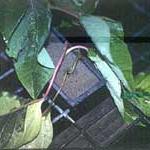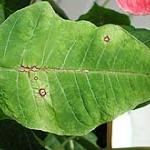Diseases of Poinsettias
Poinsettia (Euphorbia pulcherrima), the Christmas flower, is one of the most popular potted flowering plants in the United States. Due to the long production season with varying environmental conditions, a wide variety of diseases can become important at different times. Symptoms can also develop from nutrient deficiencies and excesses, especially ammonium toxicity. Bacterial blight and cutting rot caused by Erwinia carotovora, Rhizoctonia stem rot, and Pythium root rot are important early in production. Poinsettias are also subject to wide variety of foliar and stem diseases including Scab (Sphaceloma poinsettiae), Gray mold (Botrytis cinerea), Powdery mildew (Oidium species), and bacterial leaf spot (Xanthomonas campestris pv. poinsettiicola). Besides Pythium, Phytophthora root, crown, leaf and bract blight, and Black stem and root rot (Thielaviopsis basicola) can cause losses.
Bacterial blight and cutting rot can occur suddenly and spread very rapidly causing serious and rapid losses, especially during cutting propagation. Symptoms develop at the cut end of cutting but also anywhere on the cutting as a watery rot which results in complete disintegration. Succulent tissues are more quickly and severely affected. Affected cuttings that have dried can harbor active bacteria for 6 weeks. This bacterium can survive both in non-symptomatic host plants and in the rhizosphere; it is commonly present in most greenhouses. High temperature and high humidity are essential for optimum development of bacterial blight. As environmental conditions become favorable for bacterial growth (warm temperatures and high humidity), the bacteria multiply and cause disease. Spread of bacterial diseases is often the result of human activity-pruning and propagation procedures, movement of soil and plant debris by machinery or on feet, overhead irrigation, and the application of insecticides and fungicides under pressure. The use of culture-indexed cuttings is the best way to be sure that plants are free of bacteria. Preventive treatment of irrigation water with bromine or chlorine can be effective; bactericides are seldom useful.
Pythium root rot may affect a few plants or can cause the loss of a high percentage of plants, usually soon after the transplant of cuttings. Wilt and death result when infection is severe. Any surviving plants may be stunted, flower prematurely, and defoliate. Pythium species may enter greenhouses through infected cuttings, contaminated soil within or outside the greenhouse, or contaminated irrigation sources especially surface waters. The pathogen has also been shown to be present in peat moss or soilless media in some cases. Sub irrigation or ebb and flow systems can cause rapid spread when wet soils persist for long periods or floors do not drain completely. Treatment of irrigation water may become necessary. Pythium species should be excluded from the production system. High soluble salts can lead to root injury, further disposing the plants to Pythium root rot. Pythium is favored by high fertility and high moisture; avoid overwatering and overfertilizing. Pythium is a natural inhabitant of the soil and can survive there indefinitely as well as in soil and debris in the greenhouse. Use soilless growing media. Keep hose ends off the floor and avoid contaminating growth medium with soiled hands, tools, or flats. Biological control agents can be incorporated into growing media before or during transplant. Fungicide drenches can also be applied preventively. See Root diseases of Greenhouse Crops (from this list) for appropriate fungicides.
Rhizoctonia stem rot is most important during propagation which occurs during the hot months of July and August. The pathogen has a wide host range and high survival capacity in infected plant debris and soil. Rhizoctonia can be disseminated to cuttings from these sources by splashing water or other contact. Tan lesions with a dark border develop at the rooting medium line, expand rapidly, ultimately girdling stems and causing plant collapse. Leaf infections also occur when leaves contact bench surfaces; these infections grow quickly and result in additional stem cankers. Practice strict sanitation, completely removing any infected rooting strips and infected plant debris. Dry rooting strips can be soaked in fungicides prior to use.
Foliar and Stem diseases
Botrytis cinerea can cause leaf and flower bract blight as well as stem cankers; the pathogen must be controlled throughout the greenhouse as it can attack a wide array of greenhouse crops. The fungus readily invades wounds and all plant tissue, especially senescent or injured plant parts. B. cinerea requires high relative humidity and cool temperatures. It produces large amounts of spores easily visible as a gray mold which are easily spread on air currents or splashing water. The pathogen is ubiquitous in the environment and can only be controlled by a combination of management of environmental conditions, sound cultural practices, and fungicide applications. Control weeds, remove plant debris, and avoid damaging plants. Space plants to allow good air circulation, reduce humidity within the canopy, and minimize leaf wetness. Improve horizontal air flow with fans. Reduce humidity by a combination of heating and venting in the evening, particularly when warm days are followed by cool nights. Fungicides should be applied with caution as application to bracts can cause spotting, bleaching, or leave an unacceptable residue. See Botrytis Blight of Greenhouse Crops (from this list) for registered fungicides.
Powdery mildew (Oidium species) was first seen in US greenhouses in the 1990s and has since occurred sporadically. White colonies occur on both on leaves and flower bracts, reducing aesthetic value. The pathogen is not likely to survive in northern climates unless it is carried over on poinsettias in greenhouses, but it can be introduced on infected cuttings. The high temperatures of the summer months limit its growth. Powdery mildews, unlike most other fungal diseases, do not need free water to germinate and infect. They are favored by high relative humidity (greater than 95%), moderate temperatures (68°-86° F), and low light intensities. Careful scouting can allow timely fungicide treatments, but great care in fungicide applications is necessary to avoid possible flower bract injury. See Powdery Mildew Diseases of Ornamentals (from this list) for fungicide choices.
Poinsettia Scab (Spot anthracnose) is caused by Sphaceloma poinsettiae. In the past few years, infected cuttings from Central America have been the source of scab outbreaks in US greenhouses. The disease affects both leaves and stems and can cause super elongation of infected stems. The pathogen is favored by high humidity and wet growing conditions. Splashing water and insects spread the spores of S. poinsettiae easily. Cultural control options are the first line of defense in limiting the impact of poinsettia scab. Minimize water splashing and leaf wetness. Scout the crop for characteristic symptoms, especially unusually tall plants. Remove and destroy all plants that display scab symptoms. If in doubt, isolate the plants and observe them. Remove plant debris from the greenhouse. Disinfect hands, tools, and other equipment frequently and immediately after handling plants with disease symptoms. Proceed with pinching operations as pinching will make it easier to inspect plants for leaf and stem symptoms. This also increases light and air penetration, keeping the leaves and stems drier and less prone to disease development. For growers who overhead irrigate, a weekly fungicide program should be used if scab is found. A protective fungicide program can include Systhane (myclobutanil), Spectro 90WDG (thiophanate-methyl plus chlorothalonil), Daconil (chlorothalonil), Heritage, Compass, or Cygnus (strobilurins).
Bacterial leaf spot and blight is caused by Xanthomonas campestris pv. poinsettiicola. Symptoms start as small, water soaked lesions that turn yellow to tan. Severely affected plants exhibit leaf distortion, yellowing, and loss of older leaves. Infected plant material is probably the most important source of contamination as the bacteria can survive in dried leaves for as long as a year and can reside on the foliage for several months before initiating disease. The bacteria are favored by warm, wet, and humid conditions and are rapidly spread by water splash. Control must be based upon strict sanitation with the elimination of all infected stock. Diseased plant debris and affected plants should be removed from the growing area and destroyed. Greenhouse benches should be disinfected. Handling of wet foliage should be avoided. Since bacteria can be spread from plant to plant by irrigation water, minimize splashing and reduce leaf wetness by spacing, improve air circulation with fans, and sub-irrigate where possible. The disease is difficult to control without the elimination of overhead irrigation. Copper products (Champion, Nu-Cop 3, Camelot, Phyton) are registered for the control of Xanthomonas species. Mixtures of mancozeb and copper can give improved control. Bactericides are only marginally effective in managing bacterial diseases; sanitation and environmental control are important disease management principles.
Root and Stem Diseases
Two species of Phytophthora cause root, crown, leaf, flower and bract blight. Brown infected roots may be present before stunting and wilting occur. Infections on crowns and stems occur as purple black lesions that enlarge rapidly. Leaf and bract lesions appear dry and papery, grayish brown to black. Phytophthora species should be excluded from the production system as control is difficult to impossible. Pathogen-free plant material and growing media coupled with strict sanitation form the backbone of a prevention program. Contaminated irrigation sources especially surface waters may introduce and spread Phytophthora within the greenhouse. Sub irrigation or ebb and flow systems can cause rapid spread when wet soils persist for long periods or floors do not drain completely. Treatment of irrigation water may become necessary. Biological control agents can be incorporated into growing media before or during transplants. Fungicide drenches can also be applied preventively. See Root diseases of Greenhouse Crops for appropriate fungicides.
Rhizoctonia root and crown rot can result from the transplant of infected cuttings. Stem lesions develop more slowly on rooted plants. Symptoms include brown, water soaked roots, leaf yellowing, wilting, stunting, defoliation, and plant death. This pathogen prefers drier soil and is more active in the upper portion of the soil. It is favored by high nitrogen, high moisture levels, and high relative humidity. The disease is usually a problem in the cuttings and small transplant stage and the presence of wounds caused by insects (fungus gnats, shore flies) or mechanical damage can predispose plants to Rhizoctonia infection. The pathogen is easily introduced into the growth medium by soiled hands, tools, flats, and colonized transplants. Optimum control of Rhizoctonia is achieved with cultural practices and fungicidal control. Start with thorough removal of all crop debris and sanitation of benches and work areas. Use soil-less growing medium and clean pots and flats. Keep hose-ends off floors as Rhizoctonia can persist in soil and debris on concrete floors. Avoid over-irrigation and over-fertilization. Avoid close plant spacing that results in moisture and temperature levels favorable for disease development. Biological control agents can be incorporated into growing media before or during transplants. Fungicide drenches can also be applied preventively. See Root diseases of Greenhouse Crops for appropriate fungicides.
References:
Benson, D. M. et al. 2002. The History and Diseases of Poinsettia, the Christmas Flower. APSnet. http://www.apsnet.org/publications/apsnetfeatures/Pages/PoinsettiaFlower.aspx.
Moorman, G. 2006. Plant Disease Facts: Poinsettia Diseases. https://extension.psu.edu/downloadable/download/sample/sample_id/89965/
Photos: Dr. Robert L. Wick, University of Massachusetts
M. Bess Dicklow, UMass Extension Plant Diagnostic Lab
12/2013







